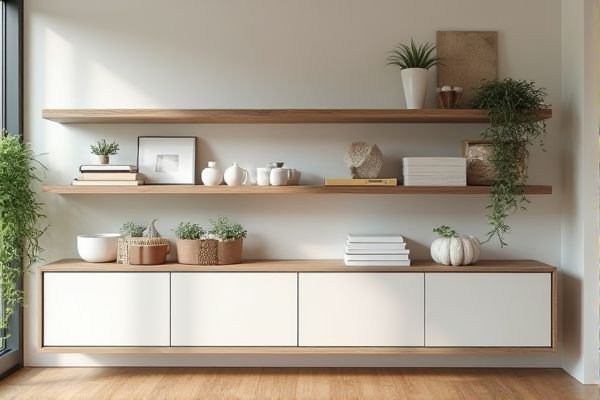
Melamine shelves offer a hard, durable surface resistant to scratches and moisture, making them ideal for everyday storage needs, while laminate shelves provide a more customizable appearance with varied textures and colors but may be less resistant to impact damage. Explore the rest of the article to discover which option best suits your storage needs and aesthetic preferences.
Table of Comparison
| Feature | Melamine Shelves | Laminate Shelves |
|---|---|---|
| Material Composition | Particleboard or MDF with melamine resin coating | Particleboard or MDF with high-pressure laminate surface |
| Durability | Moderate resistance to scratches and stains | High resistance to scratches, heat, and impact |
| Water Resistance | Limited, prone to swelling if exposed to moisture | Better water-resistant properties |
| Appearance | Smooth finish, available in various colors and patterns | Glossy or matte finish with a wide range of textures and designs |
| Cost | Generally more affordable | Typically higher priced due to enhanced durability |
| Maintenance | Easy to clean but can be damaged by harsh chemicals | Easy to maintain, resistant to most household cleaners |
| Ideal Usage | Light to moderate storage in low-moisture areas | Heavy-duty storage and high-traffic environments |
Introduction to Melamine and Laminate Shelves
Melamine shelves consist of particleboard or MDF cores coated with a durable resin-infused paper layer, offering moisture resistance and a smooth finish ideal for budget-friendly storage solutions. Laminate shelves feature a core material, often plywood or MDF, covered with a high-pressure decorative laminate that provides enhanced durability and scratch resistance compared to melamine. Both materials are popular in residential and commercial furniture, with melamine known for cost-effectiveness and laminate favored for its superior surface resilience.
Material Composition: Melamine vs Laminate
Melamine shelves consist of particleboard or MDF core coated with a durable melamine resin, providing a hard, scratch-resistant surface ideal for everyday use. Laminate shelves feature a thin plastic layer fused onto wood or particleboard, offering enhanced moisture resistance and a wider variety of textures and finishes. Choosing between melamine and laminate depends on your preference for toughness and aesthetic flexibility in shelf material composition.
Durability and Strength Comparison
Melamine shelves offer moderate durability with a hard resin coating that resists scratches and stains, making them suitable for light to medium storage needs. Laminate shelves, composed of multiple layers fused under high pressure, provide enhanced strength and superior impact resistance, ideal for heavy-duty use. Both materials resist moisture, but laminate's denser core structure ensures better longevity and stability under significant weight loads.
Aesthetic Options and Finish Variety
Melamine shelves offer a wide range of aesthetic options with smooth, durable finishes available in various colors and patterns, mimicking wood grains or solid hues to suit diverse interior styles. Laminate shelves provide an even greater variety of finishes and textures, including high-gloss, matte, and textured surfaces, allowing for customizable looks that can enhance your space's design. Both materials deliver stylish solutions, but laminate tends to offer more intricate and customizable finishes to match specific aesthetic preferences.
Cost Effectiveness and Pricing
Melamine shelves generally offer greater cost effectiveness due to their lower production costs and resistance to scratches and stains, making them a budget-friendly choice for long-term use. Laminate shelves tend to be pricier because of their layered construction and more sophisticated finish, providing enhanced durability and a higher-end aesthetic. Your decision between melamine and laminate shelves should balance initial pricing against desired durability and visual appeal to maximize value.
Installation Process and Ease
Melamine shelves feature a pre-finished surface that allows for straightforward installation, often requiring basic tools and minimal adjustments. Laminate shelves, while offering a durable and visually appealing finish, typically involve a more complex installation process due to the need for precise edge banding and potential additional finishing steps. For your project, choosing melamine shelves can simplify the assembly, especially if ease and speed of installation are priorities.
Maintenance and Cleaning Requirements
Melamine shelves require minimal maintenance and can be easily cleaned with a damp cloth and mild detergent, making them highly resistant to stains and scratches. Laminate shelves also offer straightforward cleaning but may be more susceptible to chipping or peeling if abrasive materials or harsh chemicals are used. Your choice depends on how durable and low-maintenance you prefer your shelving material to be for daily upkeep.
Resistance to Moisture and Stains
Melamine shelves offer superior resistance to moisture and stains due to their non-porous resin coating, making them ideal for humid environments and easy to clean. Laminate shelves, while also fairly resistant, can be more susceptible to moisture damage if the edges are not properly sealed, leading to potential swelling or warping over time. Choosing melamine enhances durability in kitchens or bathrooms where exposure to water and spills is frequent.
Eco-Friendliness and Sustainability
Melamine shelves offer better eco-friendliness due to their durable resin-infused surface, which reduces the need for frequent replacement and minimizes waste. Laminate shelves often involve more synthetic adhesives and plastics, leading to lower recyclability and a larger environmental footprint. Choosing melamine shelves can enhance your commitment to sustainability by supporting longer-lasting, less resource-intensive materials.
Best Uses: Ideal Applications for Each Type
Melamine shelves are best suited for closets, storage rooms, and furniture where cost-effective, moisture-resistant surfaces are required, making them ideal for organizing shoes, books, and household items. Laminate shelves offer greater durability and aesthetic variety, perfect for high-traffic areas such as kitchens, offices, or retail displays where strength and a polished appearance matter. You should choose melamine for budget-friendly, practical storage and laminate for stylish, long-lasting shelving solutions in demanding environments.
 homyna.com
homyna.com